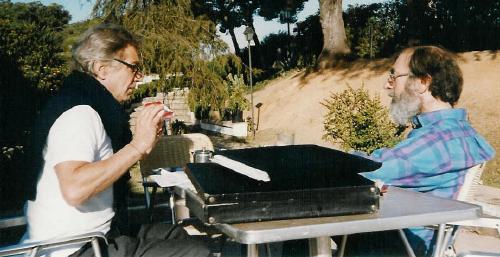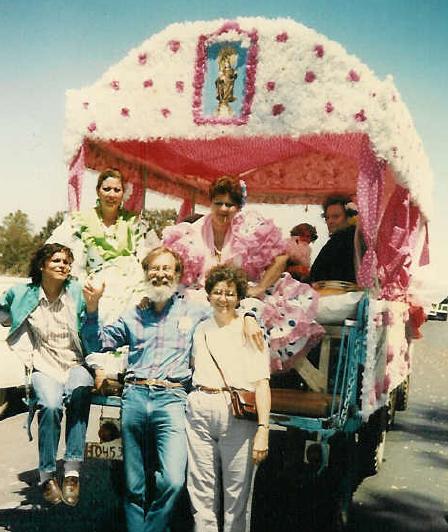Stories
Psychology for Revolutionaries
Psychology for Peace Activists
Why there are so few women warriors
The Seville Statement on Violence
A theory of mental illness
* * *
The need to address the common myth that war is biologically determined was intuitively evident to me, but needed scientific proof. For this I undertook a study with one of my undergraduate students, Sarah Bosch, in which we measured the effect of beliefs on behavior. We showed conclusively, using elegant techniques from social psychology, that, as the title of the paper indicates: "The Myth That War Is Intrinsic to Human Nature Discourages Action for Peace by Young People." In other words, students who told us in an initial interview that they believed that war is biologically determined were less likely to have taken any action for peace when interviewed again one month later. The paper is available on the Internet at http://www.culture-of-peace.info/myth/title-page.html .
The Seville Statement on Violence was originally conceived and inspired by Santiago Genoves, as I describe in my published history of the Seville Statement in the Journal of Peace Research and in the UNESCO brochure that I prepared on the Seville Statement. They are available on the internet at (respectively) http://www.culture-of-peace.info/ssov/title-page.html and http://www.culture-of-peace.info/brochure/titlepage.html .
Santiago had taken part in one of the UNESCO meetings on race as part of its series of important statements on race which denied the fundamental premises of racism. I first met him at a meeting of the International Society for Research on Aggression in Haren, Netherlands, in August 1980 where I had gone to honor my professor John Flynn. It was there in a special session I had helped organize on the ethics of aggression research, that Santiago suggested we approach UNESCO for a Statement on Race.
Compared to other scientists at the Haren meeting, Santiago was remarkably flamboyant and interesting. Inspired by Thor Heyeradahl, with whom he had once worked, Santiago had run raft trips across the Atlantic Ocean and written about them in popular magazines, spicing his accounts with the sex lives of the men and women on board. He was from a generation older than mine, having fled to Mexico with his family as a teenager from fascism after the defeat of the left in the Spanish Civil War.
After the meetings we went together to Amsterdam, picked up the attractive waitress at the restaurant where we ate and went out together to a nightclub. I got into a brawl with the bouncers when I got onto the stage and danced barefoot with the stage dancers. The bouncers demanded that I wear shoes and I refused, pointing out the the women were not only barefoot but nude. I was thrown own bodily and Santiago told me, "Don't ever try this in Mexico because they use their pistols!"
 |
At first, UNESCO seemed to agree to run a conference to draft a Statement on Violence. This was conveyed by the distinguished Swiss Director of Peace and Human Rights, Pierre de Senarclens, in letters to me and to our committee member Pierre Karli in the Spring of 1982. But then I received a letter from Karli in March 1983 in which he says, "I heard recently from Pierre de Senarclens that my letter to the Director-General of UNESCO stirred up the minds and gave rise to lively - and somehow unpleasant - discussions. Pierre de Senarclens did not wish to go ito any details, but he gave me to understand that these discussions - together with some others - have led him to resign as of April 1, 1983, from his position as Director of the Division for Human Rights and Peace." Years later, I would hear more of de Senarclens from our mutual friend Christine von Furstenberg at UNESCO.
The de Senarclens correspondence came at a time of great upheaval at UNESCO, with a new Assistant Director-General for Social Sciences, an African woman, who got into fierce fights with many of the staff members in the Social Science Sector. It was also at this time that the United States and United Kingdom withdrew from UNESCO, apparently trying to bring it to its knees over their political disagreements with the organization and its African Director-General, M'Bow.
Our committee then contacted various National Commissions of UNESCO and eventually obtained the agreement of the Spanish National Commission to host the conference, and Santiago and I convinced a Spanish neurobiologist, Martin Ramirez, to host a conference to draft the Seville Statement.
When Lindsay and I (along with Sarah Bosch as well) arrived in Seville for the conference, I found a huge banner across the stage from the scientific front for the Moonie sect. I told Martin I would not meet under such a sign. "I don't care if you got money from the Moonies," I said, "but you don't have to advertise it any more than the fact that I below to the Communist Party." The sign then came down.
My presentation to the opening conference was dramatic, as I laid out the arguments in the form that would eventually be taken by the Statement: "It is scientifically incorrect to say...."
At one point during the opening conference, Martin took me aside and said, "I'm now going to introduce you to the Spanish John F. Kennedy." And he introduced me to Federico Mayor, a brain scientist and former UNESCO officer, at that time with the Spanish National Commission for UNESCO. Sure enough, like Kennedy he was handsome with blue eyes and coal black hair, and extremely charming and well-spoken. It would be over a year later that he would be elected as the dark-horse Director-General of UNESCO.
The most important contributions to the text came from John Paul Scott and Ben Ginsburg (see their photo at the Behavior Genetics Association). Their papers entitled The Biological Basis of Warfare and The Behaviors and the Genetics of Aggression were distributed to everyone and were later reprinted in the book edited by Ramirez, Groebel and Hinde. I had come to know and appreciate their capacities in both the International Society for Research on Aggression and the Behavior Genetics Association. For a while I thought all was lost when Ginsburg and Scott refused to accept the anti-colonialist message drafted by Ashis: "Misuse of scientific theories and data to justify violence and war is not new but has been made since the advent of modern science. For example, the theory of evolution has been used to justify not only war, but also genocide, colonialism, and suppression of the weak." But Santiago and I stood our ground in defense of it, and eventually they acceded.
At first we worked in Seville in an outdoor courtyard of the University, an historic spot because the building had once housed the 18th Century cigar factory where the true Carmen had worked. Then, Martin had arranged for us to go on a 4-day retreat following at a beautiful monastery called La Rabida where during each day the drafting group would meet and every night three of us, Santiago, Ashis Nandy from India and I would work to consolidate the text. At one point, I remember, Riitta Wahlstrom and Bonnie Carter (see their photos in the Seville Statement Newsletter) came to us in tears because we had eliminated most of their work in social psychology and emphasized, instead, the "hard science" of Scott and Ginsburg, but we said that we had to keep the text short and concentrated. At the end, it was Santiago who suggested that we close with the paraphrase of his fellow anthropologist Margaret Mead that war was an invention and peace could be invented.
After finalizing the Statement, a group of us went to the Rocio festival to celebrate (Lindsay and I, Martin and Diana Mendoza, and Jose Luis Diaz from Mexico). Our scrapbook is filled with dramatic photos from this ancient and colorful spectacle where thousands of the "brotherhoods" come by oxen and horseback to the small chapel of Rocio and drink and dance the days away, the women dressed in the most fantastic dancing gowns.

The most important work began when I got home from Seville and I started work on the Seville Statement Newsletter to publicize what we had agreed on at Seville.
 |
Stages
1986-1992
Fall of Soviet Empire
1992-1997
UNESCO Culture of Peace Programme